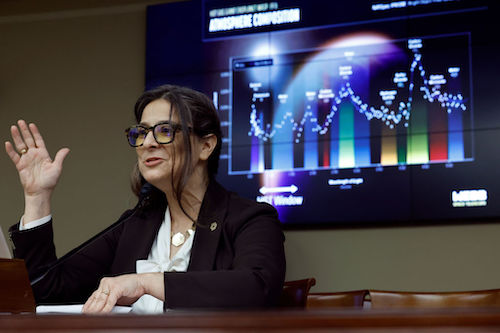Natalie Batalha, professor astronomy and astrophysics and director of astrobiology at UC Santa Cruz and leader of the NASA Interdisciplinary Consortium for Astrobiology Research, presented her team’s initial scientific findings from the James Webb Space Telescope (JWST) to the space and aeronautics subcommittee on Nov. 16 during a hearing titled, “Unfolding the Universe: Initial science results from the James Webb Space Telescope.”
The purpose of the congressional hearing was to receive expert testimony on the initial science and scientific findings of the JWST, as well as plans for future scientific investigations.
UC Santa Cruz astronomers are involved in projects within each of the four main science themes JWST is studying (first stars and galaxies, galaxies over time, lifecycle of stars, and planetary systems). Batalha is leading a large international team who are studying planets around other stars (exoplanets), one of the most exciting areas in which JWST is expected to open new territory.
Batalha described to the subcommittee how the JWST is ushering in a new era of exoplanet science. She noted that this progress is largely due to the characterization of exoplanet atmospheres as enabled by JWST technology.
In a groundbreaking discovery earlier this year, Batalha and her team found unambiguous evidence of carbon dioxide in the atmosphere of an exoplanet. The discovery demonstrated the power of the JWST to deliver unprecedented observations of exoplanet atmospheres.
In research that was released today, Batalha and her team used the JWST to observe a Saturn-mass planet called WASP-39b, which orbits very close to a sun-like star about 700 light-years from Earth. They were able to identify multiple chemical species in the planet’s atmosphere, including sodium, potassium, water, carbon dioxide and carbon monoxide. They also detected sulfur dioxide, a molecule produced from chemical reactions triggered by high-energy light from the planet’s host star. Batalha explained that this type of chemistry, called photochemistry, is fundamental for life on Earth to thrive.
Spectrometers aboard the JWST allow scientists to measure the amount of light blocked at each wavelength, building up a “spectrum” that reveals the chemical makeup of a planet’s atmosphere. When a planet, in orbit around its host star, transits in front of the star, some of the starlight passes through the planet’s atmosphere on its way to Earth’s telescopes. The atoms and molecules in the atmosphere absorb the starlight at distinct wavelengths, effectively blocking slightly different fractions of light from reaching a telescope.
This method of studying planetary atmospheres is called transmission spectroscopy, and it has been employed by the Hubble Space Telescope and large ground-based telescopes on a small number of planets. The JWST is extending the capability and increasing the sensitivity of this method by collecting more light in a stable environment across a broader range of (infrared) wavelengths.
When asked about what she’s most excited to learn from the JWST, Batalha noted that the most common type of planet scientists know about is a type of planet that is not found in our solar system: an “intermediate” between rocky, terrestrial planets such as Earth or Mars, and gas giants like Jupiter and Saturn. Scientists do not yet understand their nature or whether such planets can host life, but the JWST will be able to characterize and shed more light on this class of planets.
Batalha concluded that transmission spectra, which “contain so many clues about the nature of the universe,” are “extremely compelling, and I’m really looking forward to seeing more spectra so we can understand the diversity of all of the worlds that are out there.”
The James Webb Space Telescope is an international program led by NASA with its partners, the European Space Agency and the Canadian Space Agency, and is operated by the Space Telescope Science Institute.



